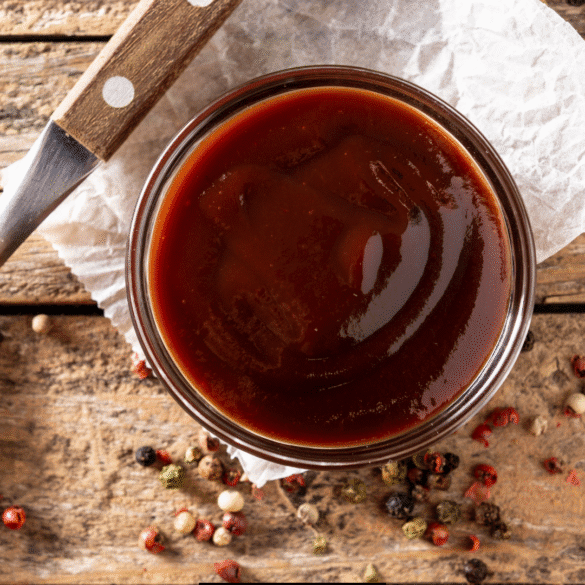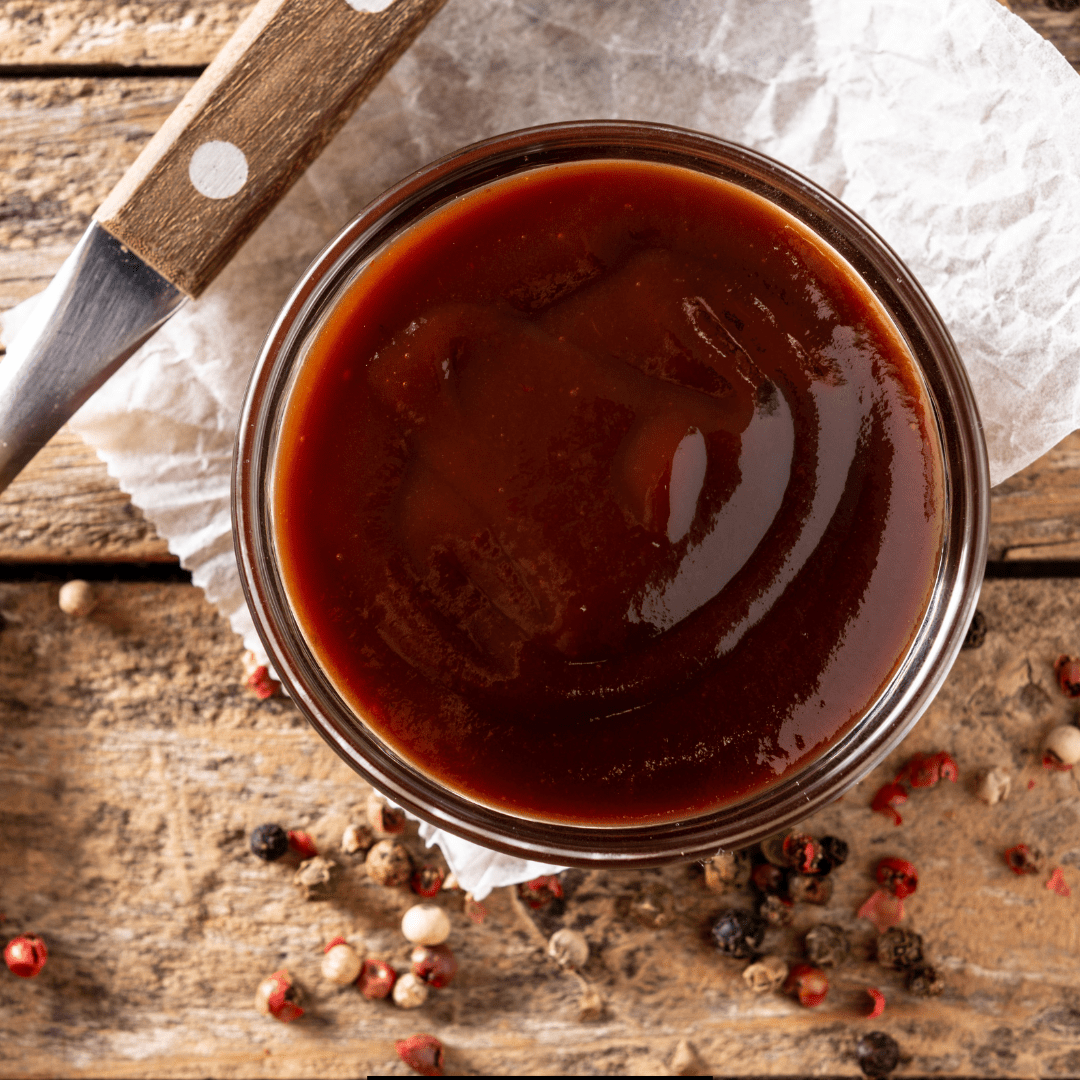I first fell in love with Japanese barbecue sauce during a cozy dinner at a small, tucked-away yakitori shop in Tokyo. The smell of smoky grilled chicken skewers coated in a sweet and salty glaze filled the air, and after one bite, I knew this was a sauce I couldn’t live without. The beauty of it lies in its versatility—it’s the perfect balance of umami, sweet, and tangy with hints of ginger and garlic dancing across your taste buds.
Table of Contents
How to make Japanese Barbecue Sauce
Japanese Barbecue Sauce is a savory-sweet condiment and marinade inspired by Japanese flavors, often compared to a mix between teriyaki and soy-based dipping sauces.
Ingredients
Base Ingredients:
- Soy Sauce (1/2 cup)
- Mirin (1/3 cup)
- Sake (2 tablespoons)
- Sugar (2–3 tablespoons)
- Garlic (2 cloves, minced)
- Ginger (1 tablespoon, grated)
Optional Additions:
- Honey or Maple Syrup (1 tablespoon): For natural sweetness and a thicker glaze.
- Sesame Oil (1 teaspoon): Adds nutty depth and fragrance.
- Miso Paste (1 tablespoon): For an extra boost of umami, especially if you plan to use the sauce as a marinade.
Instructions
- Heat the Base: In a small saucepan, combine the soy sauce, mirin, sake, and sugar. Turn the heat to medium and let it gently simmer as you stir to dissolve the sugar completely (about 1–2 minutes).
- Add Aromatics: Stir in the minced garlic and grated ginger. Let the mixture simmer on low for an additional 4–5 minutes to allow the flavors to meld. Stir occasionally to prevent sticking or burning.
- Thicken the Sauce: If you want a thicker consistency, mix 1 teaspoon of cornstarch with 1 tablespoon of water to make a slurry. Add this to the sauce while stirring, and simmer for another minute until it thickens.
- Adjust Flavor: Taste the sauce! If it’s too salty for your preference, add a splash of water or an extra teaspoon of honey/maple syrup to balance the flavor.
- Cool and Store: Once the sauce is ready, remove it from the heat and let it cool completely. Transfer to a clean jar or airtight container and store in the refrigerator for up to 1–2 weeks.
Tips for the Perfect Japanese Barbecue Sauce
- Choose Your Soy Sauce Carefully: A good-quality soy sauce makes all the difference. Japanese soy sauces like Kikkoman are ideal, but feel free to use what you have.
- Don’t Skip the Mirin and Sake: These two ingredients are critical for achieving the authentic sweetness and complexity of Japanese barbecue sauce. You can find them in most Asian grocery stores or online.
- Customize the Flavor: Want it spicier? Add a dash of togarashi (Japanese chili flakes) or a few drops of sriracha. Prefer a smokier profile? Add a small amount of smoked paprika.
- Use Fresh Ingredients: Always use fresh garlic and ginger for aromatic, bold flavors. Powdered substitutes won’t give the same results.
What to serve with
Japanese barbecue sauce is incredibly versatile and pairs well with a variety of dishes. Its sweet, salty, and savory profile complements both protein and vegetable options, making it a perfect addition to many meal types.
Yakitori (Grilled Chicken Skewers)
Recipe Idea: Skewer chunks of chicken thigh, brush with Japanese barbecue sauce, and grill until caramelized and cooked through. Serve with a sprinkle of sesame seeds and sliced green onions for an authentic experience.
Teriyaki Beef
Recipe Idea: Marinade thin slices of steak in Japanese barbecue sauce for a few hours, then grill or pan-sear until juicy and tender. Serve over steamed rice and garnish with chopped scallions.
Pork Ribs or Chops
Recipe Idea: Coat pork ribs or chops with Japanese barbecue sauce before and during grilling for a delicious and authentic flavor. Serve with grilled vegetables or a side of rice.
Ingredients Substitutes
Sometimes you might not have all the traditional ingredients required for Japanese barbecue sauce on hand. But don’t worry—you can still craft a delicious version with accessible substitutes.
1. Soy Sauce
Why It’s Used:
Soy sauce forms the salty, umami base of Japanese barbecue sauce. It’s crucial for the savory backbone that ties all the flavors together.
Substitutes:
- Tamari (Gluten-Free Option): Tamari is very similar to soy sauce, but it lacks gluten, making it an ideal choice for those with dietary restrictions.
- Coconut Aminos (Low Sodium/Healthier Option): A soy-free alternative with a slightly sweeter taste. It may require less sugar in the recipe.
- Liquid Aminos: Another gluten-free option, though it tends to have a milder and less complex flavor than soy sauce.
2. Mirin
Why It’s Used:
Mirin, a sweet Japanese rice wine, adds mellow sweetness and a glossy finish to the sauce. It’s essential for that authentic Japanese flavor.
Substitutes:
- Dry Sherry or Sweet Marsala Wine: Both have a slightly similar sweetness and alcohol content.
- White Wine with Sugar: Mix 1 tablespoon of sugar with 3 tablespoons of white wine as a substitute.
- Rice Vinegar + Sugar: Combine 3 parts rice vinegar with 1 part sugar to mimic the sweet acidity of mirin.
- **Honey or Maple Syrup (Non-Alcoholic): If you need a non-alcoholic option, these can add sweetness and a bit of stickiness. Adjust quantity based on desired flavor.
3. Sake
Why It’s Used: Sake adds depth and richness to the sauce with its mild alcoholic kick and slightly fruity flavor.
Substitutes:
- Dry White Wine: This is an easy and accessible alternative, providing a similar acidity to sake.
- Dry Vermouth or Sherry: Works well as a substitute with comparable flavor complexity.
- Rice Vinegar (Diluted): Rice vinegar can be diluted with equal parts water if an alcoholic substitute is not an option.
- Stock (Non-Alcoholic Option): Chicken, vegetable, or mushroom stock can provide body and depth without alcohol, though it changes the flavor slightly.
4. Sugar
Why It’s Used: Sugar gives Japanese barbecue sauce its characteristic sweetness and helps create the glossy, caramelized texture when the sauce is cooked.
Substitutes:
- Honey: A natural sweetener that mimics both the sweetness and stickiness of sugar.
- Maple Syrup: Adds a subtle earthiness to the flavor profile.
- Brown Sugar: Works perfectly and can add a touch of molasses-like depth. Use the same quantity as white sugar.
- Coconut Sugar: A less-refined sweetener that works as a healthy alternative, though it has a deeper caramel-like flavor.
5. Garlic
Why It’s Used: Garlic adds aromatic sharpness and depth to the sauce, balancing the sweet and salty flavors.
Substitutes:
- Garlic Powder: Use 1/2 teaspoon of garlic powder as a replacement for 1 clove of fresh garlic. Add it early in the cooking process to fully release its flavor.
- Minced Shallots or Onions: While not identical, they can provide a similar aromatic base.
- Ginger (Additional): If garlic isn’t an option, simply increase the amount of ginger for a slightly different but still delicious flavor.
6. Ginger
Why It’s Used: Ginger gives the sauce a zingy, warm spiciness that rounds out the flavors.
Substitutes:
- Ground Ginger: Use 1/4 teaspoon of ground ginger for every 1 tablespoon of fresh ginger. Add it early to dissolve fully.
- Ginger Paste: Commonly available in stores and a great alternative to fresh ginger.
- Galangal: A close relative of ginger, commonly used in Southeast Asian cooking. It has a sharper, more citrusy flavor.
Final Thoughts
With this homemade Japanese barbecue sauce, you can recreate the irresistible flavors of Japanese cuisine from the comfort of your own kitchen.
More Sauce Recipes:
- Copycat Wendy’s Mystery Sauce Recipe
- Homemade Torani Caramel Sauce Recipe
- Pumpkin Spice Sauce Recipe
- Copycat Dustin Poirier’s Hot Sauce Recipe

Ingredients
Base Ingredients:
- Soy Sauce (1/2 cup)
- Mirin (1/3 cup)
- Sake (2 tablespoons)
- Sugar (2–3 tablespoons)
- Garlic (2 cloves, minced)
- Ginger (1 tablespoon, grated)
Optional Additions:
- Honey
- Sesame Oil (1 teaspoon)
- Miso Paste (1 tablespoon)
Instructions
- Heat the Base: In a small saucepan, combine the soy sauce, mirin, sake, and sugar. Turn the heat to medium and let it gently simmer as you stir to dissolve the sugar completely (about 1–2 minutes).
- Add Aromatics: Stir in the minced garlic and grated ginger. Let the mixture simmer on low for an additional 4–5 minutes to allow the flavors to meld. Stir occasionally to prevent sticking or burning.
- Thicken the Sauce: If you want a thicker consistency, mix 1 teaspoon of cornstarch with 1 tablespoon of water to make a slurry. Add this to the sauce while stirring, and simmer for another minute until it thickens.
- Adjust Flavor: Taste the sauce! If it's too salty for your preference, add a splash of water or an extra teaspoon of honey/maple syrup to balance the flavor.
- Cool and Store: Once the sauce is ready, remove it from the heat and let it cool completely. Transfer to a clean jar or airtight container and store in the refrigerator for up to 1–2 weeks.
